A Study of Frequency Domain Reflectometry Technique for High-Voltage Rotating Machine Winding Condition Assessment
Abstract
:1. Introduction
2. Theory and Modeling
2.1. Coils for the Experiment
2.2. TDR vs. FDR
2.3. Transmission Line Model
2.4. Experimental Setups
- End-winding discharge caused by main insulation damage, physically located at 2.4 m from the near end terminal;
- Turn-to-turn short between the first and second turns, physically located at 2.4 m (first turn) and 7.2 m (second turn) from the the near end terminal;
- Loose coil, simulated by loosening copper shield by 20 cm, physically located at 4.5 m from the near end terminal;
- Local overheating at 3.5 m from the near end terminal;
- Tracking between coils at the winding-end section, between the remote end terminal of the first coil and the overhang section of the second coil.
3. Results
3.1. FDR Results of Good Coils
3.2. Coil Fault Study
3.3. Water Pump Investigation
4. Discussion
5. Conclusions
Author Contributions
Funding
Data Availability Statement
Acknowledgments
Conflicts of Interest
References
- Thorsen, O.V.; Dalva, M. Failure identification and analysis for high voltage induction motors in petrochemical industry. In Proceedings of the 1998 IEEE Industry Applications Conference, Thirty-Third IAS Annual Meeting, St. Louis, MO, USA, 12–18 October 1998; pp. 291–298. [Google Scholar]
- Ertugrul, N.; Soong, W.; Dostal, G.; Saxon, D. Fault tolerant motor drive system with redundancy for critical applications. In Proceedings of the IEEE 33rd Annual IEEE Power Electronics Specialists Conference, Cairns, QLD, Australia, 23–27 June 2002; pp. 1457–1462. [Google Scholar]
- Rodriguez, P.; Sahoo, S.; Pinto, C.; Sutowicz, M. Field Current Signature Analysis for Fault Detection in Synchronous Motors. In Proceedings of the IEEE 10th International Symposium on Diagnostics for Electrical Machines, Power Electronics and Drives (SDEMPED), Guarda, Portugal, 1–4 September 2015; pp. 246–252. [Google Scholar]
- Tallam, R.M.; Lee, S.B.; Stone, C.G.; Kliman, G.B.; Yoo, J.; Habetler, T.G.; Harley, R.G. A survey of methods for detection of stator related faults in induction machines. In Proceedings of the IEEE International Symposium on Diagnostics for Electric Machines, Power Electronics and Drives(SDEMPED), Atlanta, GA, USA, 24–26 August 2003; pp. 35–46. [Google Scholar]
- IEEE 43-2013; IEEE Recommended Practice for Testing Insulation Resistance of Electric Machinery. Institute of Electrical and Electronics Engineers, Inc.: New York, NY, USA, 2013.
- IEEE 286-2000; IEEE Recommended Practice for Measurement of Power Factor Tip–Up of Electric Machinery Stator Coil Insulation. Institute of Electrical and Electronics Engineers, Inc.: New York, NY, USA, 2000.
- IEEE 62.2-2004; IEEE Guide for Diagnostic Field Testing of Electric Power Apparatus—Electrical Machinery. Institute of Electrical and Electronics Engineers, Inc.: New York, NY, USA, 2004.
- David, E.; Lamarre, L. Progress in DC Testing of Generator Stator Windings: Theoretical Considerations and Laboratory Tests. IEEE Trans. Energy Convers. 2010, 25, 49–58. [Google Scholar] [CrossRef]
- Farahani, M.; Borsi, H.; Gockenbach, E. Dielectric response studies on insulating system of high voltage rotating machines. IEEE Trans. Dielectr. Electr. Insul. 2006, 13, 212–226. [Google Scholar] [CrossRef]
- Helgeson, A. Analysis of Dielectric Response Measurement Methods and Dielectric Properties of Resin-Rich Insulation During Processing. Ph.D. Thesis, KTH Royal Institute of Technology, Stockholm, Sweden, 2000. [Google Scholar]
- David, E.; Lamarre, L. Low–frequency dielectric response of epoxy-mica insulated generator bars during multi-stress aging. IEEE Trans. Dielectr. Electr. Insul. 2007, 14, 212–226. [Google Scholar] [CrossRef]
- Farahani, M.; Borsi, H.; Gockenbach, E.; Kaufhold, M. Partial discharge and dissipation factor behavior of model insulating systems for high voltage rotating machines under different stresses. IEEE Electr. Insul. Mag. 2005, 21, 5–19. [Google Scholar] [CrossRef]
- Pemen, A.J.M.; van der Laan, P.C.T. Wout de Leeuw Propagation of partial discharge signals in stator windings of turbine generators. IEEE Trans. Energy Convers. 2006, 21, 155–161. [Google Scholar] [CrossRef]
- Stone, G.C.; Sedding, H.G.; Costello, M.J. Application of partial discharge testing to motor and generator stator winding maintenance. IEEE Trans. Ind. Appl. 1996, 32, 459–464. [Google Scholar] [CrossRef]
- Renforth, L.; Giussani, R.; Knutsen, T.; Aardal, B.; Kienner, T.E. A novel solution for the reliable online partial discharge monitoring (olpd) of vsd–operated EX/ATEX HV motors. In Proceedings of the 2016 Petroleum and Chemical Industry Conference Europe (PCIC Europe), Berlin, Germany, 14–16 June 2016; pp. 1–9. [Google Scholar]
- IEC 60076-18:2012; Power transformers—Part 18: Measurement of Frequency Response, Edition 1.0. The International Electrotechnical Commission (IEC): Geneva, Switzerland, 2012.
- Cusido, J.; Romeral, L.; Ortega, J.A.; Rosero, J.A.; Garcia, E.A. Fault Detection in Induction Machines Using Power Spectral Density in Wavelet Decomposition. IEEE Trans. Ind. Electron. 2008, 55, 633–643. [Google Scholar] [CrossRef]
- Lee, S.B.; Stone, G.C.; Daviu, K.A.; Gyftakis, K.N.; Strangas, E.G.; Maussion, P.; Platero, C.A. Condition Monitoring of Industrial Electric Machines: State of the Art and Future Challenges. IEEE Ind. Electron. Mag. 2020, 14, 158–167. [Google Scholar] [CrossRef]
- Zhang, Y.; Yun, H.; Cheng, J.; Taylor, N. An Intelligent and Automated Online System for Condition Monitoring of Mission–Critical Induction Motors. In Proceedings of the International Council on Electrical Engineering Conference (ICEE), Seoul, Republic of Korea, 28 June–2 July 2022; pp. 934–939. [Google Scholar]
- Glass, S.W.; Jones, A.M.; Fifield, L.S.; Hartman, T.S. Bulk and Distributed Electrical Cable Non-Destructive Examination Methods for Nuclear Power Plant Cable Aging Management Programs; Pacific Northwest National Laboratory: Washington, DC, USA, 2016. [Google Scholar]
- Fantoni, P.F. NPP Wire System Aging Assessment and Condition Monitoring State–of–the–Art Report; Institutt for Energiteknikk, OECD Halden Reactor Project: Halden, Norway, 2004. [Google Scholar]
- Roberts, A. Stress grading for high voltage motor and generator coils. IEEE Electr. Insul. Mag. 1995, 11, 26–31. [Google Scholar] [CrossRef]
- Cheng, J.; Taylor, N.; Werelius, P. Nonlinear Dielectric Properties of the Stator and Transformer Insulation Systems. IEEE Trans. Dielectr. Electr. Insul. 2022, 29, 240–246. [Google Scholar] [CrossRef]
- Radiodetection Application Note: TDR Metallic Time Domain Reflectometer Guide. Available online: https://www.rjmcompany.com/cable-pipe-locators/TDR-metallic-time-domain-reflectometer-guide.pdf (accessed on 20 August 2023).
- Frickey, D.A. Using the Inverse Chirp–Z Transform for Time–Domain Analysis of Simulated Radar Signals; Idaho National Engineering Laboratory Reports: Washington, DC, USA, 1995. [Google Scholar]
- Maier, T.; Leibfried, T.; Elcheroth, E. Mathematical–detection-algorithms for cable diagnostics and investigations with Line–Resonance–Analysis. In Proceedings of the International Conference on Condition Assessment Techniques in Electrical Systems (CATCON), Bangalore, India, 10–12 December 2015; pp. 40–45. [Google Scholar]
- MOHR Test and Measurement LLC Application Note: TDR vs. FDR: Distance to Fault. Available online: https://www.mohr-engineering.com/TDR_vs_FDR_Distance_to_Fault-A.php (accessed on 31 July 2023).
- Keysight Technologies Application Note: Time Domain Analysis Using a Network Analyzer. Available online: https://www.keysight.com/us/en/assets/7018-01451/application-notes/5989-5723.pdf (accessed on 31 July 2023).
- Pozar, M.D. Microwave Engineering, 3rd ed.; Wiley: Hoboken, NJ, USA, 2012; pp. 49–64. [Google Scholar]
- Huang, R.; Zhang, D. Application of Mode Matching Method to Analysis of Axisymmetric Coaxial Discontinuity Structures Used in Permeability and/OR Permittivity Measurement. Prog. Electromagn. Res. 2007, 67, 205–230. [Google Scholar] [CrossRef]
- Paul, R.C. Introduction to Electromagnetic Compatibility, 2nd ed.; John Wiley & Sons Inc.: Hoboken, NJ, USA, 2006; pp. 192–198. [Google Scholar]
- Alam, M.N.; Coats, D.; Dougal, R.A.; Ali, M. Surface wave propagation measurements in unshielded XLPE power cables. In Proceedings of the IEEE Antennas and Propagation Society International Symposium (APSURSI), Orlando, FL, USA, 7–13 July 2013; pp. 1770–1771. [Google Scholar]
- Stone, C.G. Electrical Insulation For Rotating Machines—Design, Evaluation, Aging, Testing and Repair; IEEE Press: Piscataway, NJ, USA, 2004; pp. 137–174. [Google Scholar]
- Abeywickrama, N.; Serdyuk, Y.; Gubanski, S. High–Frequency Modeling of Power Transformers for Use In Frequency Response Analysis. IEEE Trans. Power Deliv. 2008, 23, 2042–2049. [Google Scholar] [CrossRef]
- Glass, S.W.; Fifield, L.S.; Jones, A.M.; Hartman, T.S. Frequency domain reflectometry modeling and measurement for nondestructive evaluation of nuclear power plant cables. In Proceedings of the 18th International Conference on Environmental Degradation of Materials in Nuclear Power Systems—Water Reactors, Online, 20 April 2017; pp. 1267–1280. [Google Scholar]
- Kumar, S.; Mukherjee, D.; Guchhait, P.K.; Banerjee, R.; Srivastava, A.K.; Vishwakarma, D.N.; Saket, R.K. A Comprehensive Review of Condition Based Prognostic Maintenance (CBPM) for Induction Motor. IEEE Access 2019, 7, 90690–90704. [Google Scholar] [CrossRef]
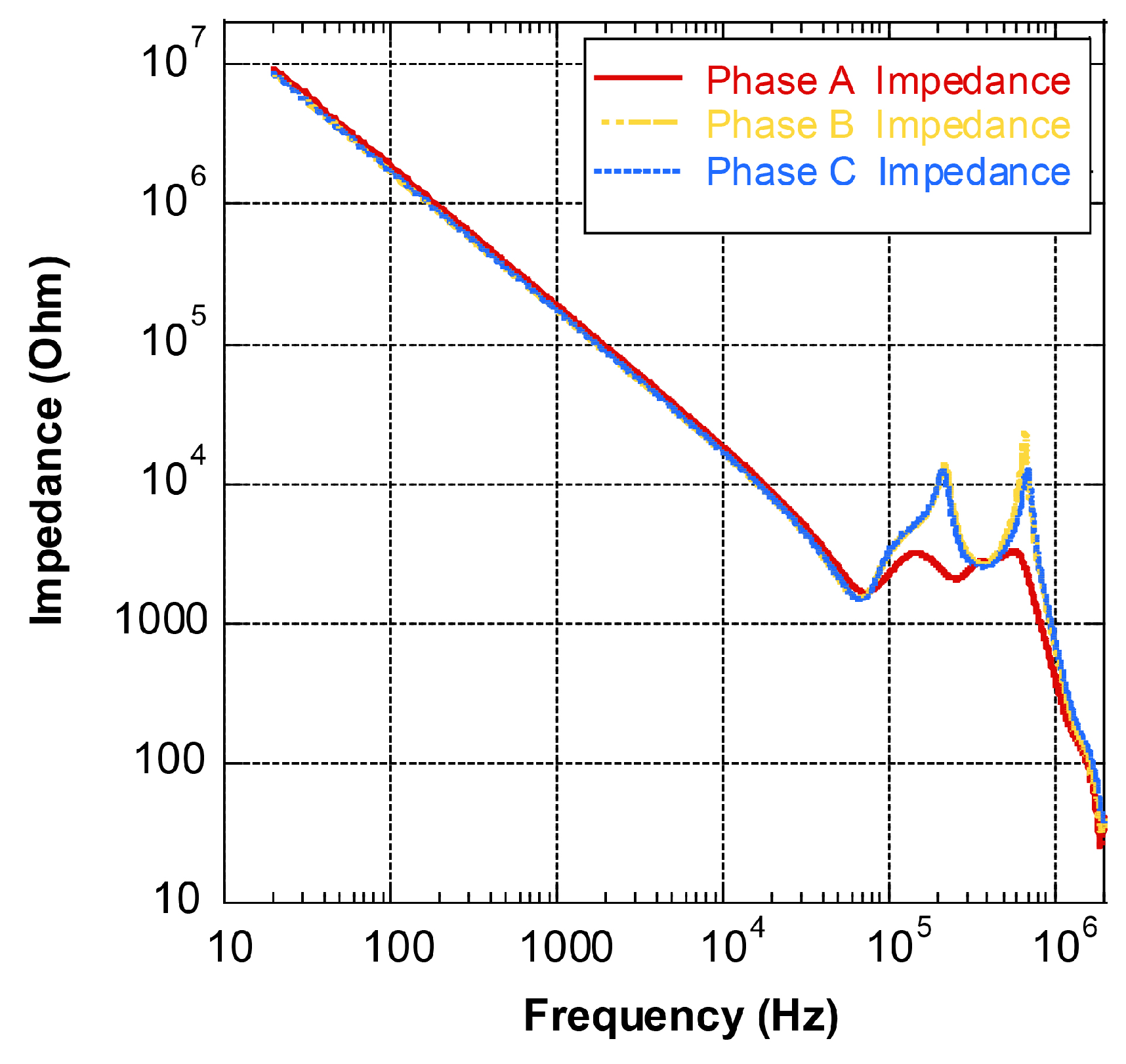


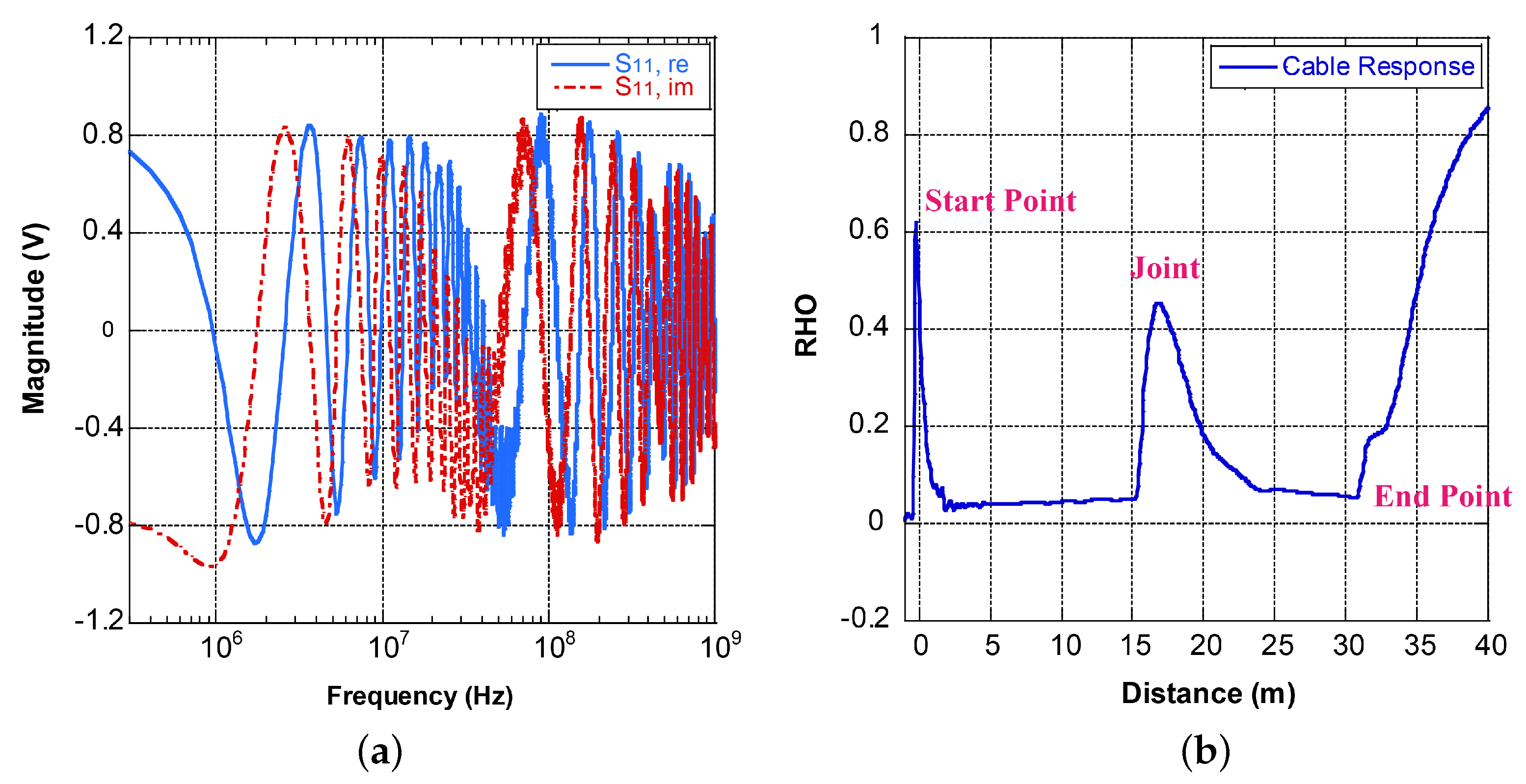
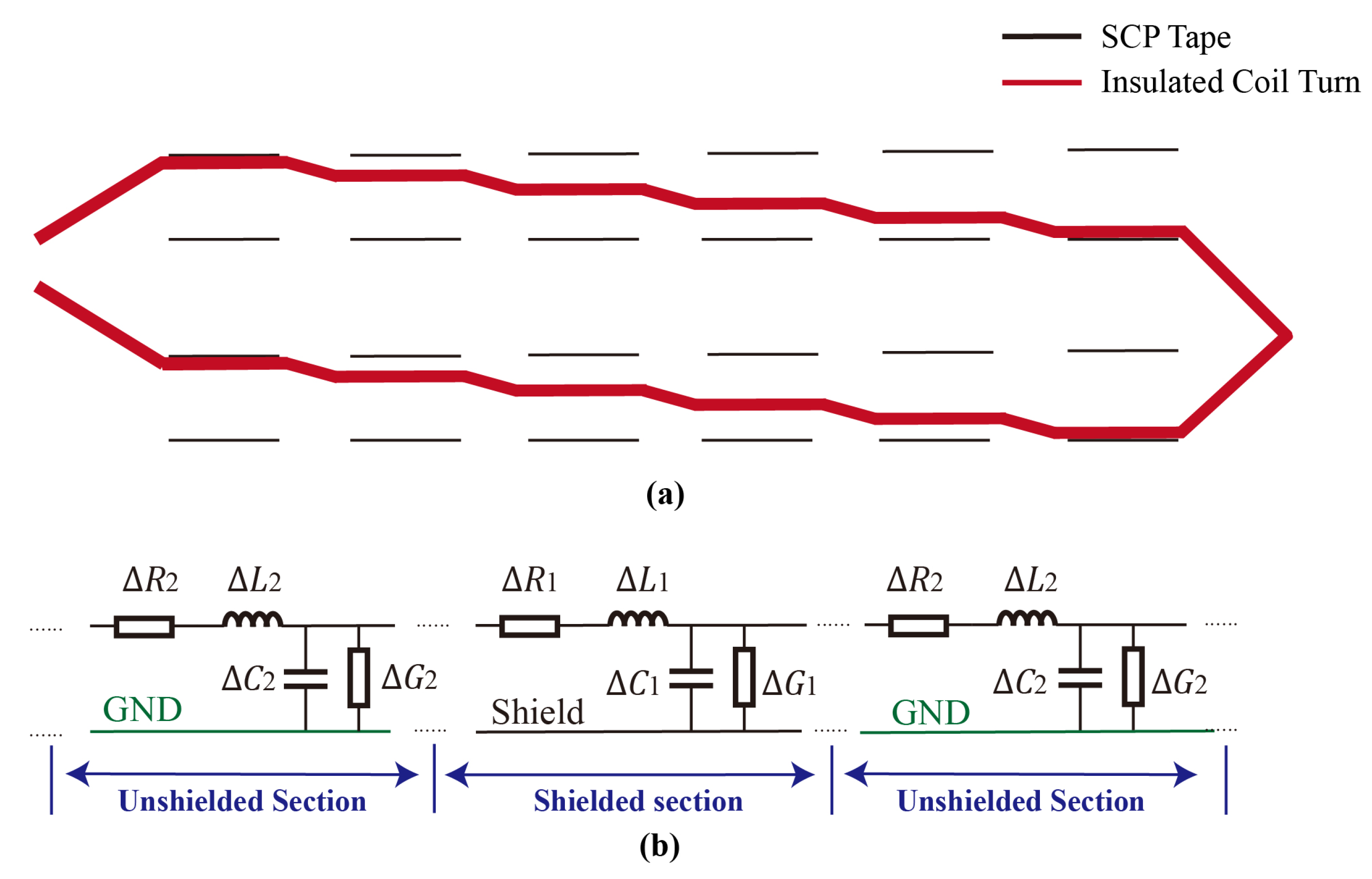
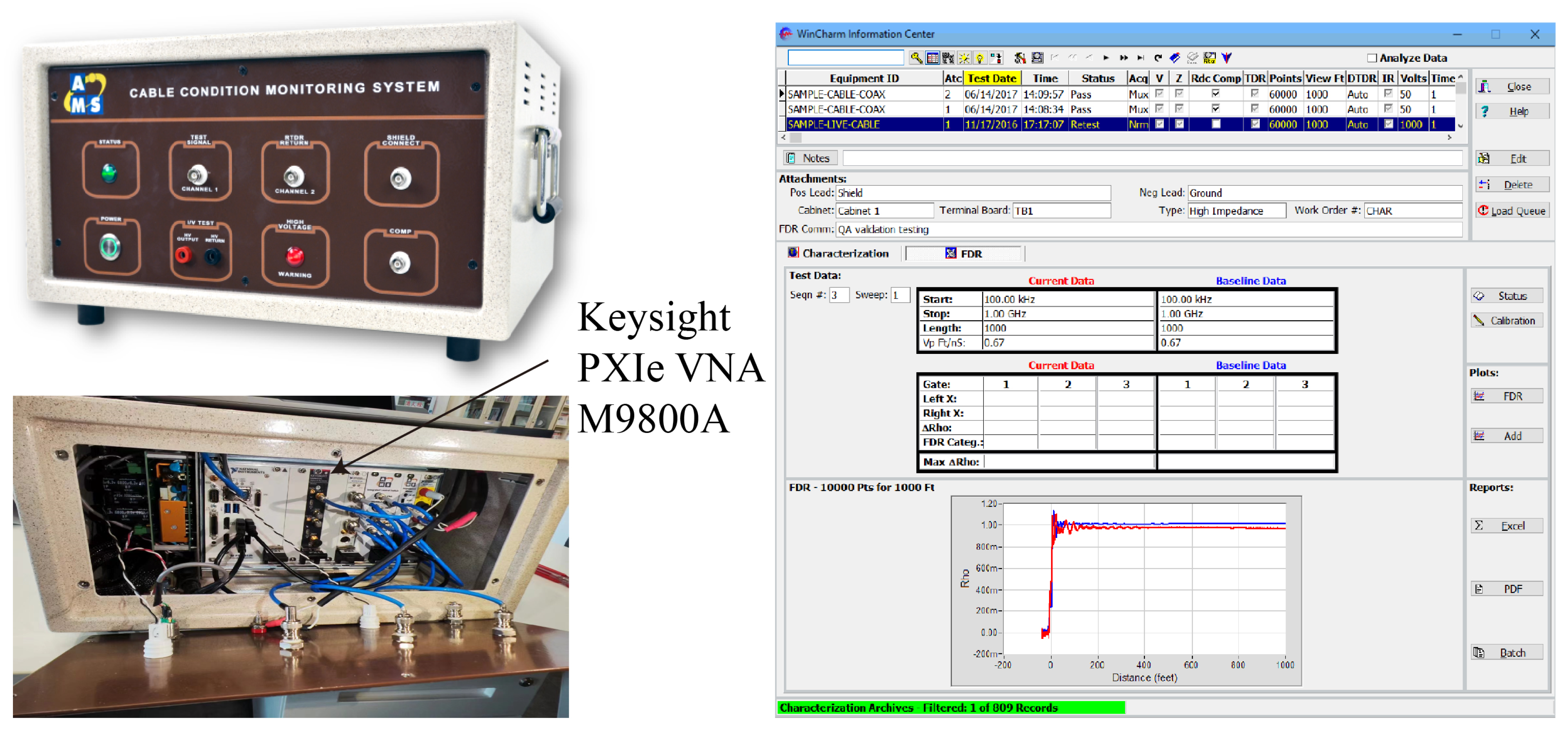
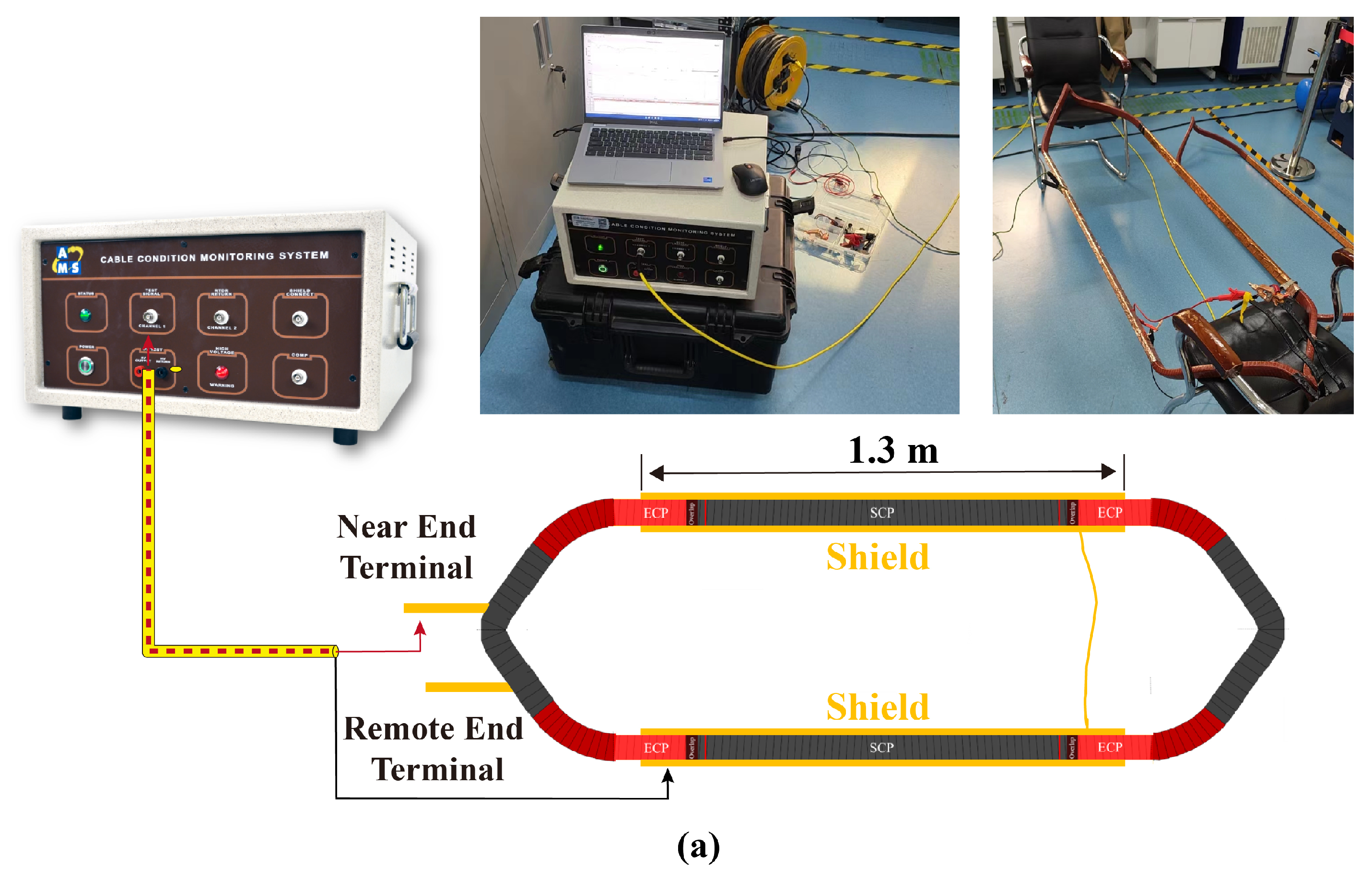
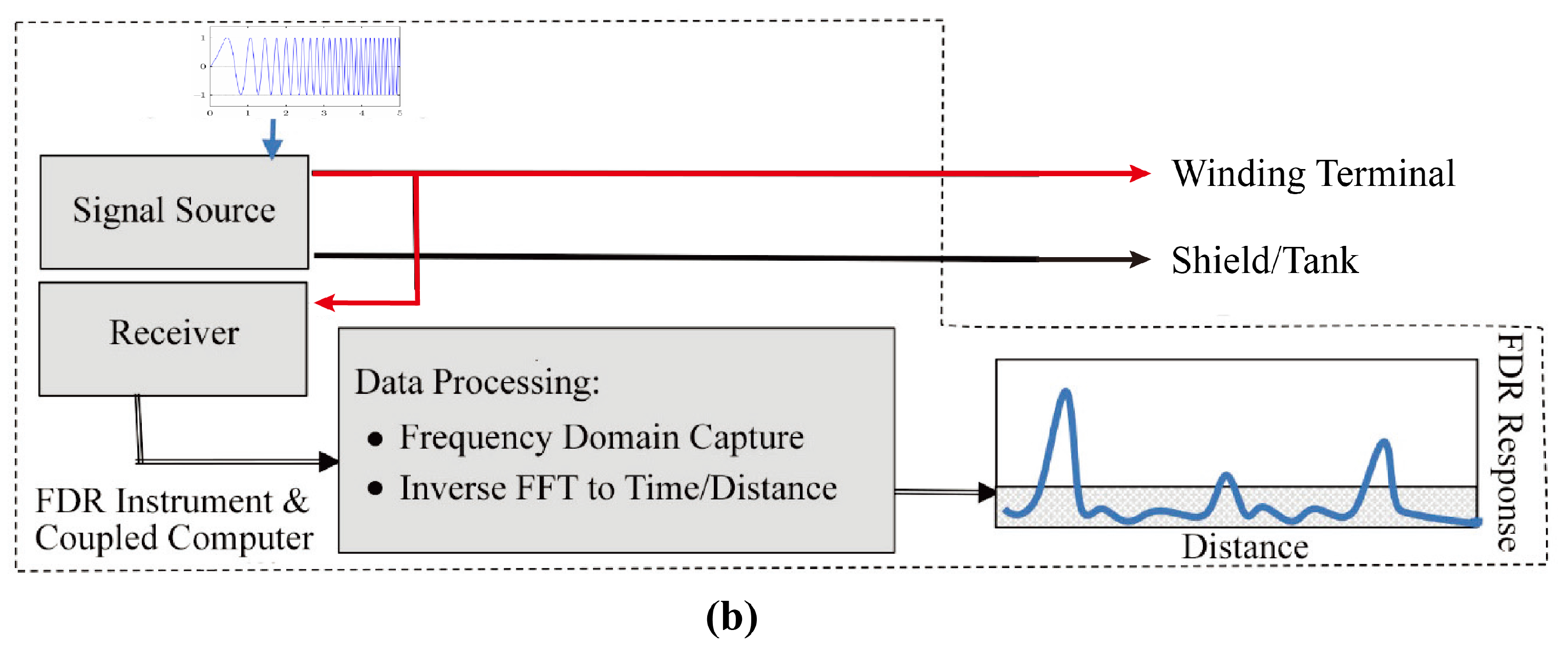

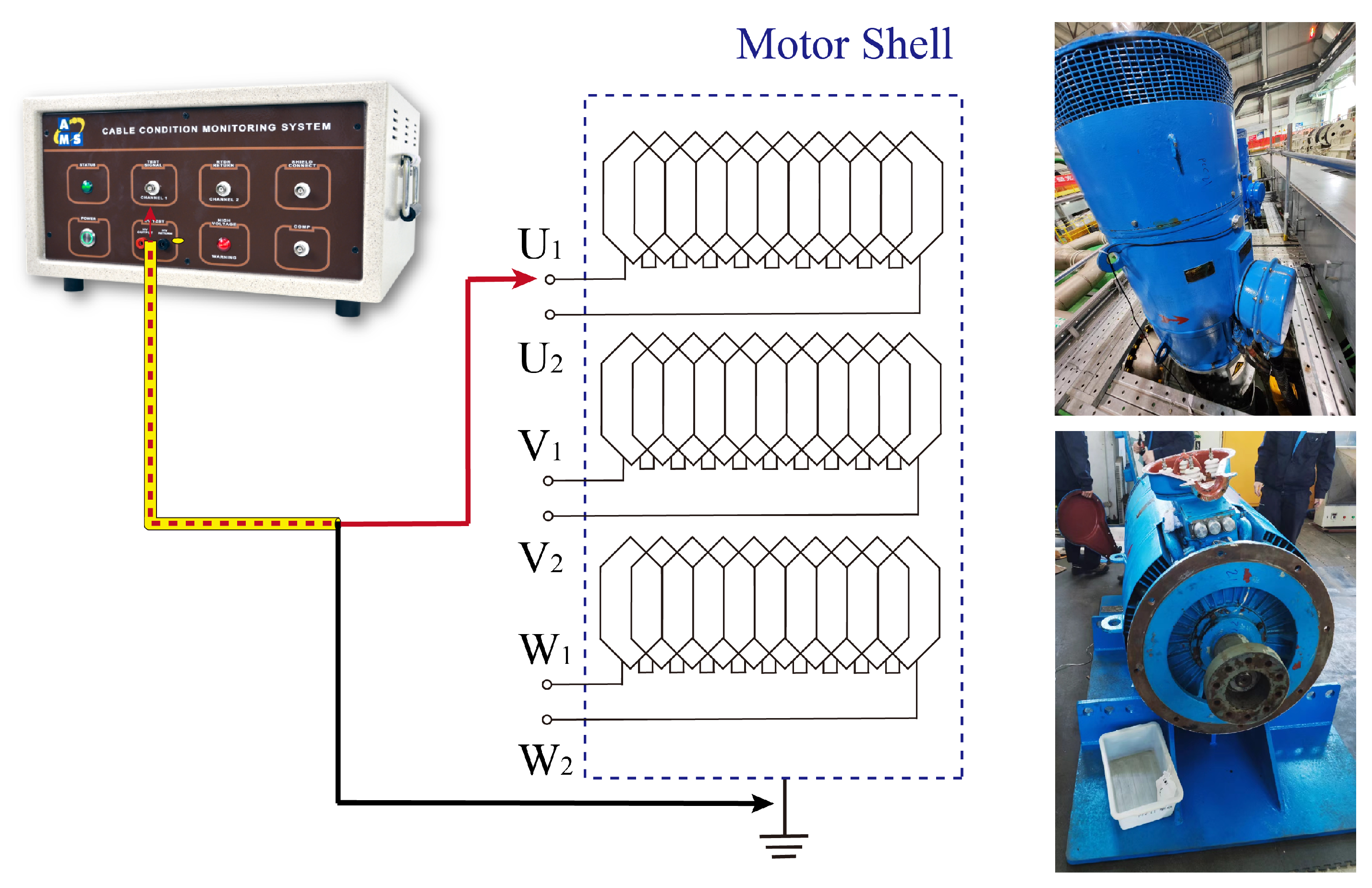
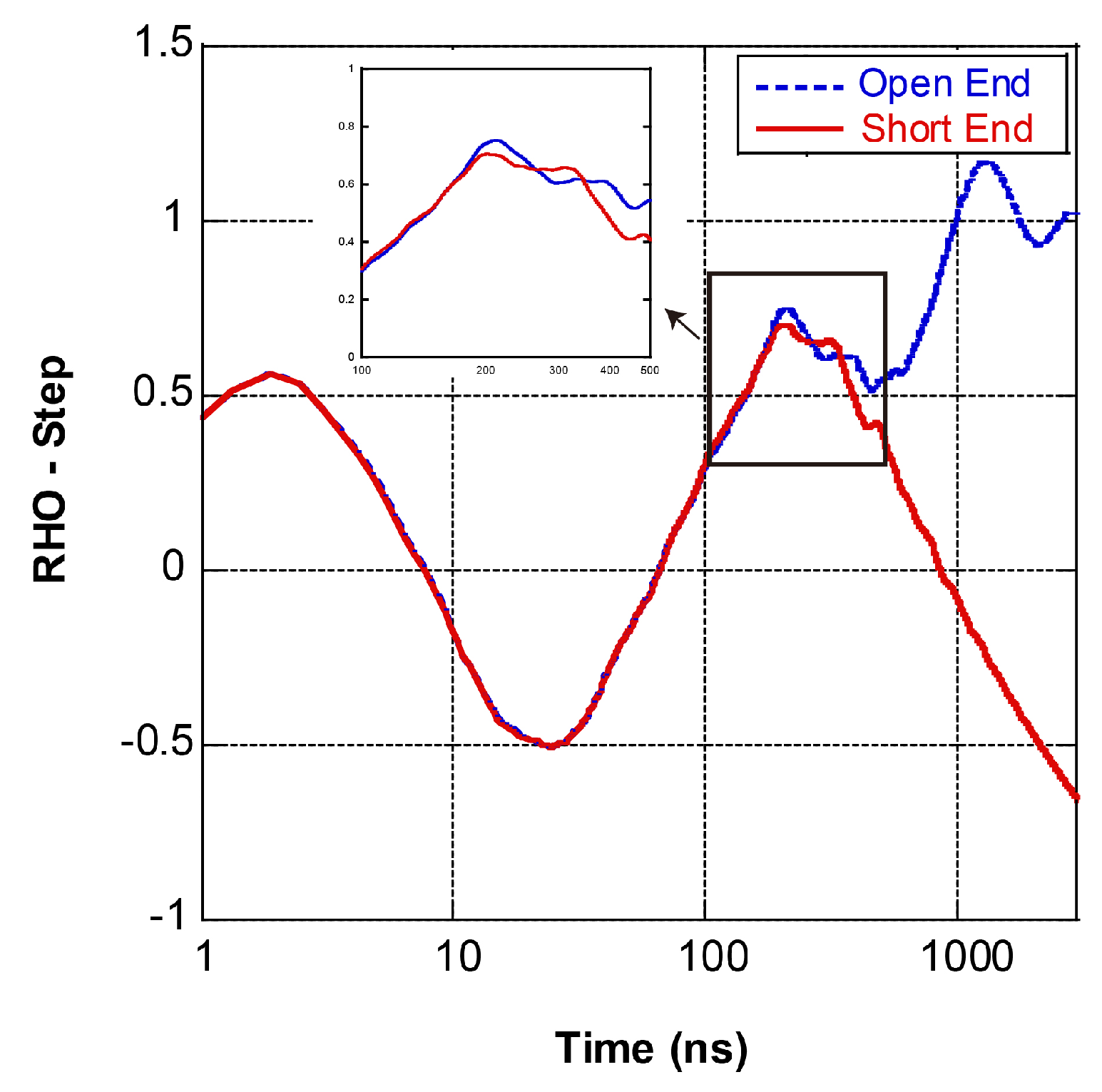
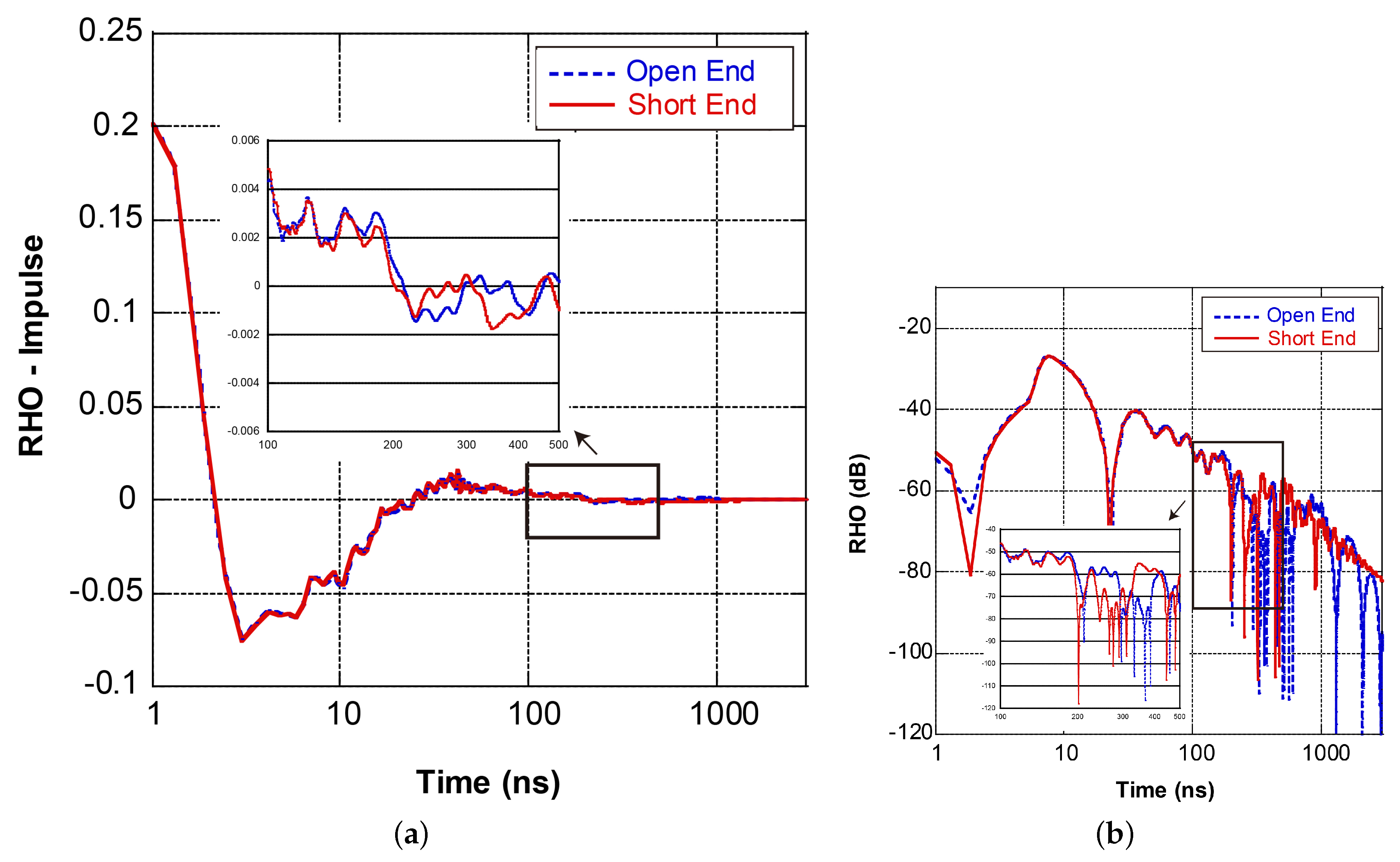
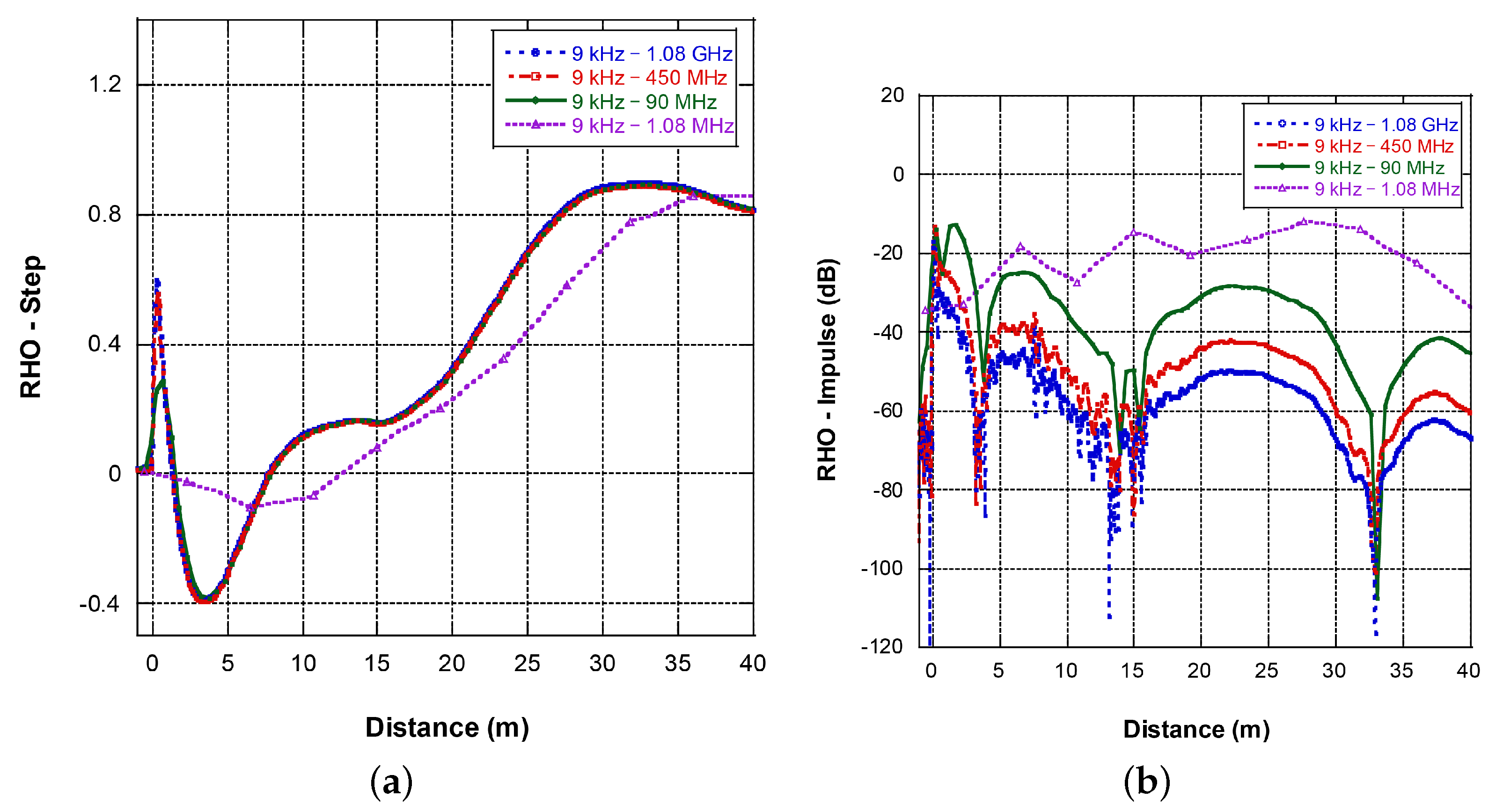
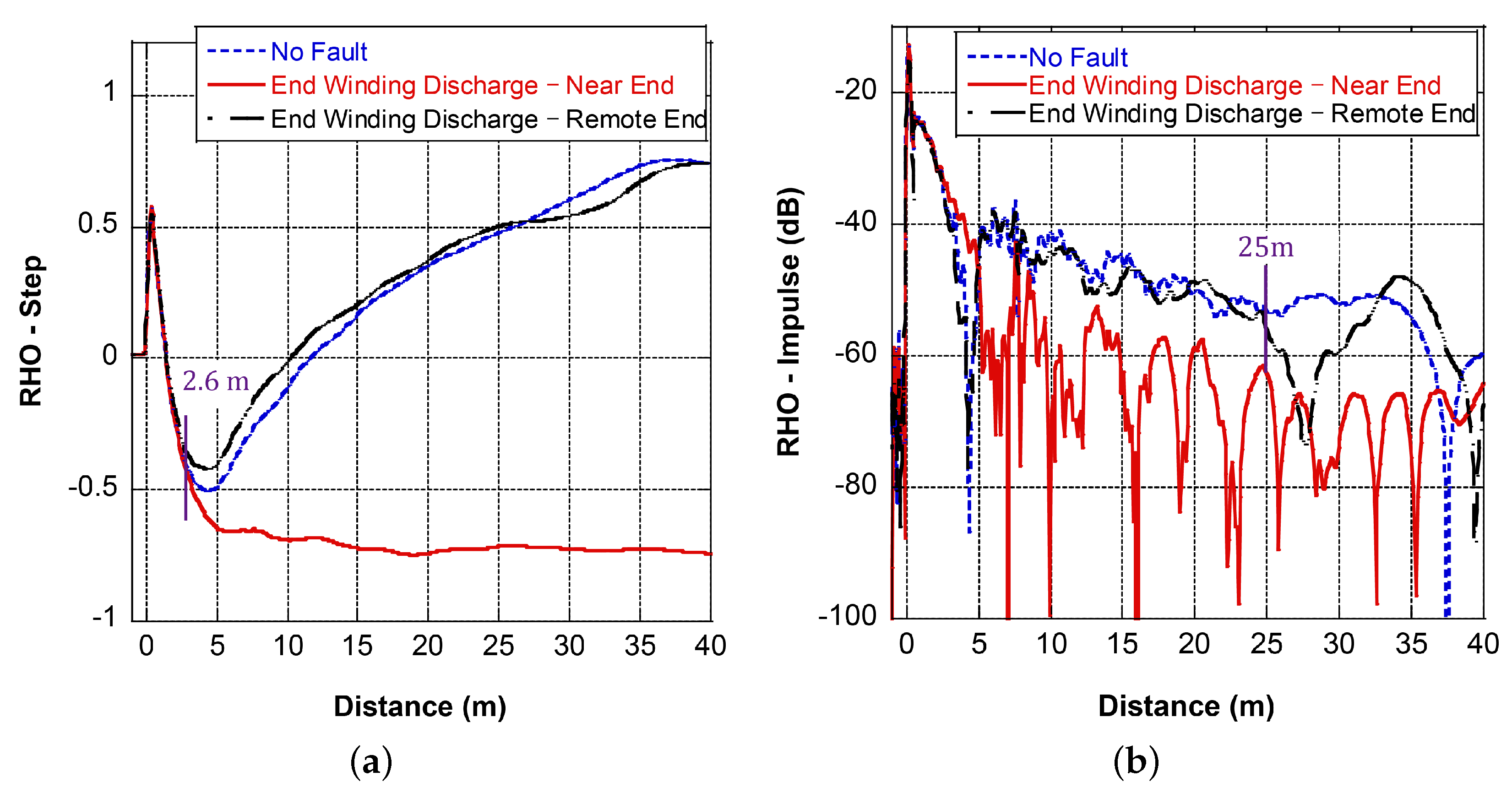

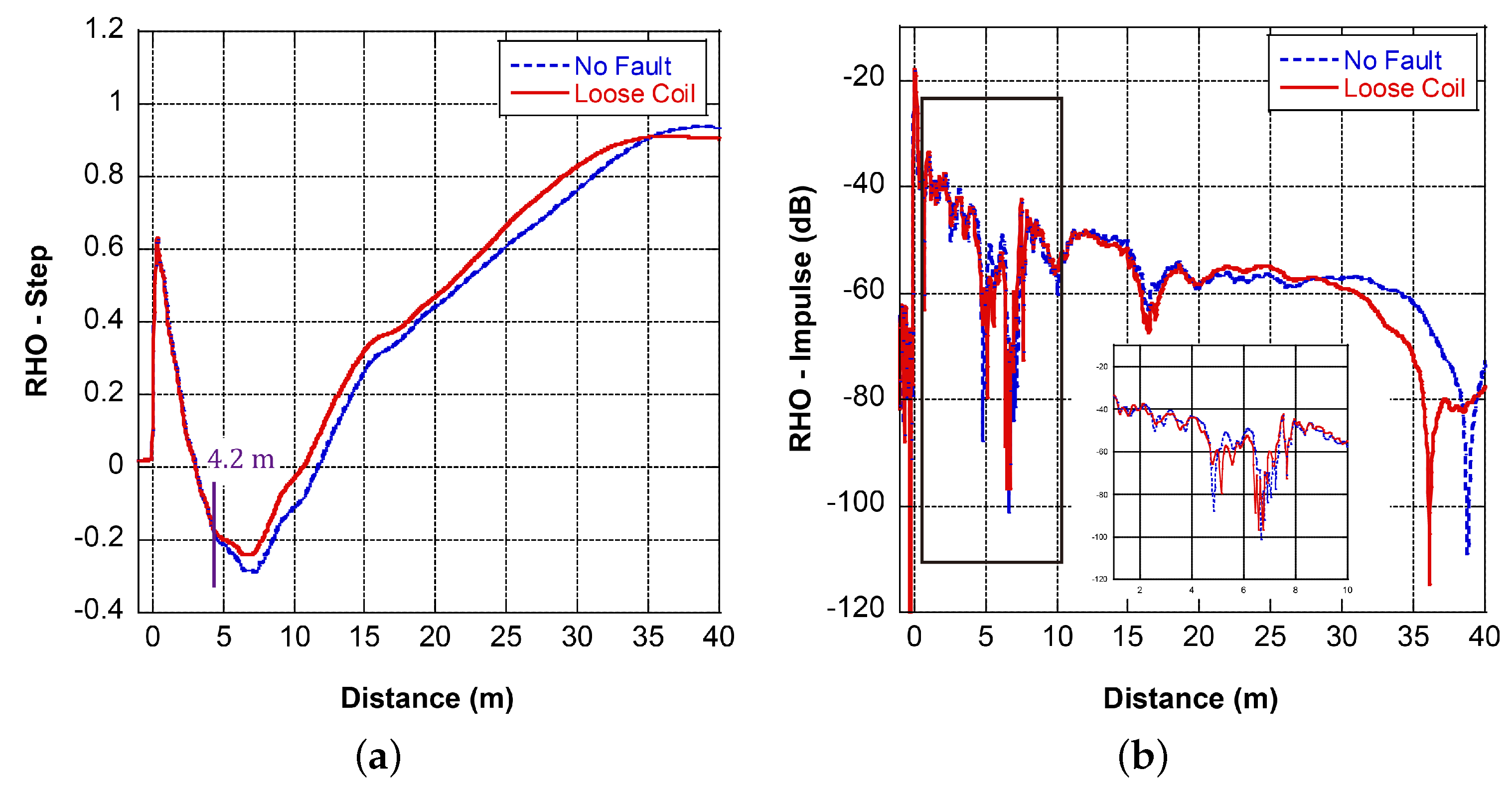
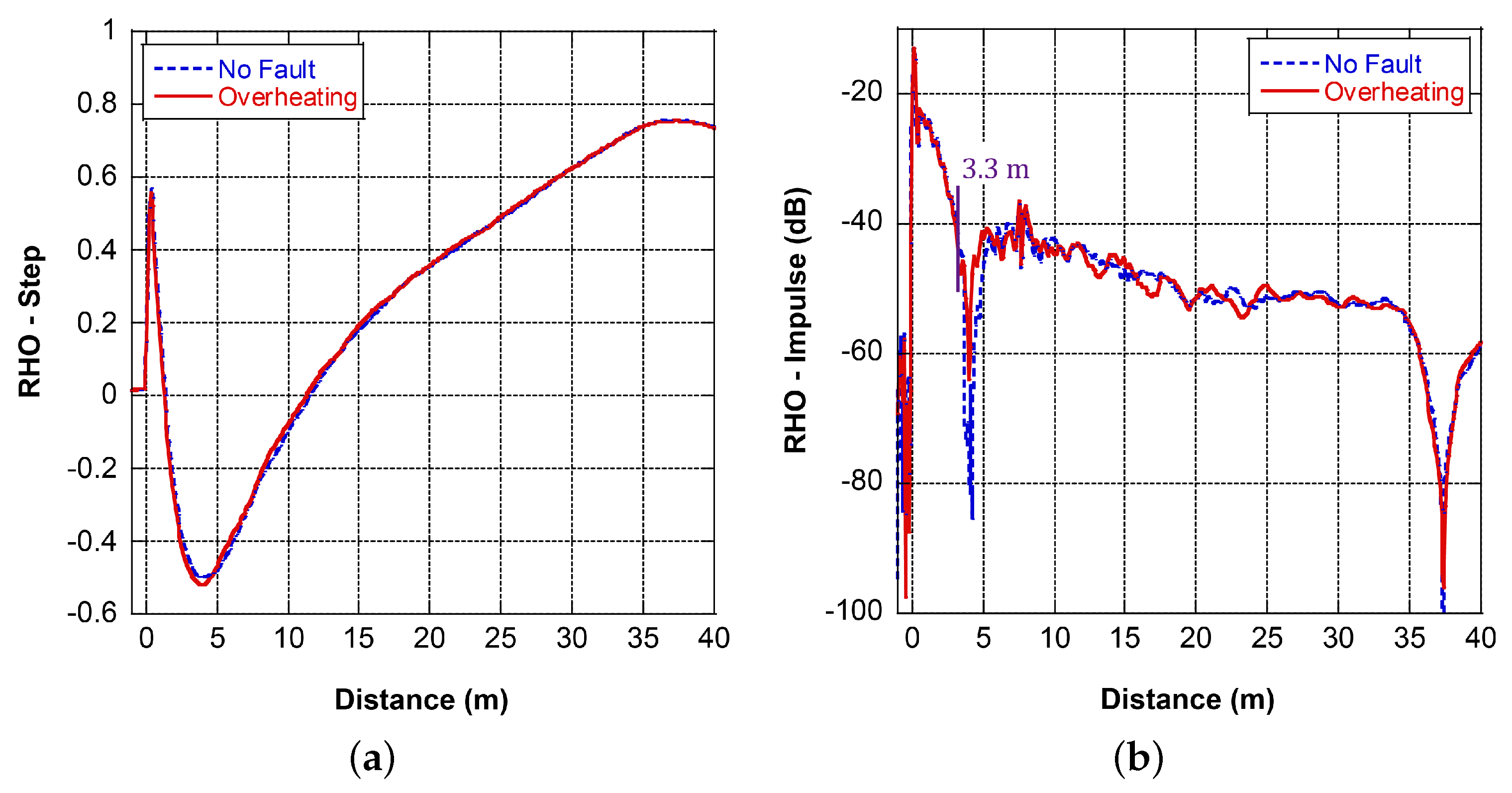
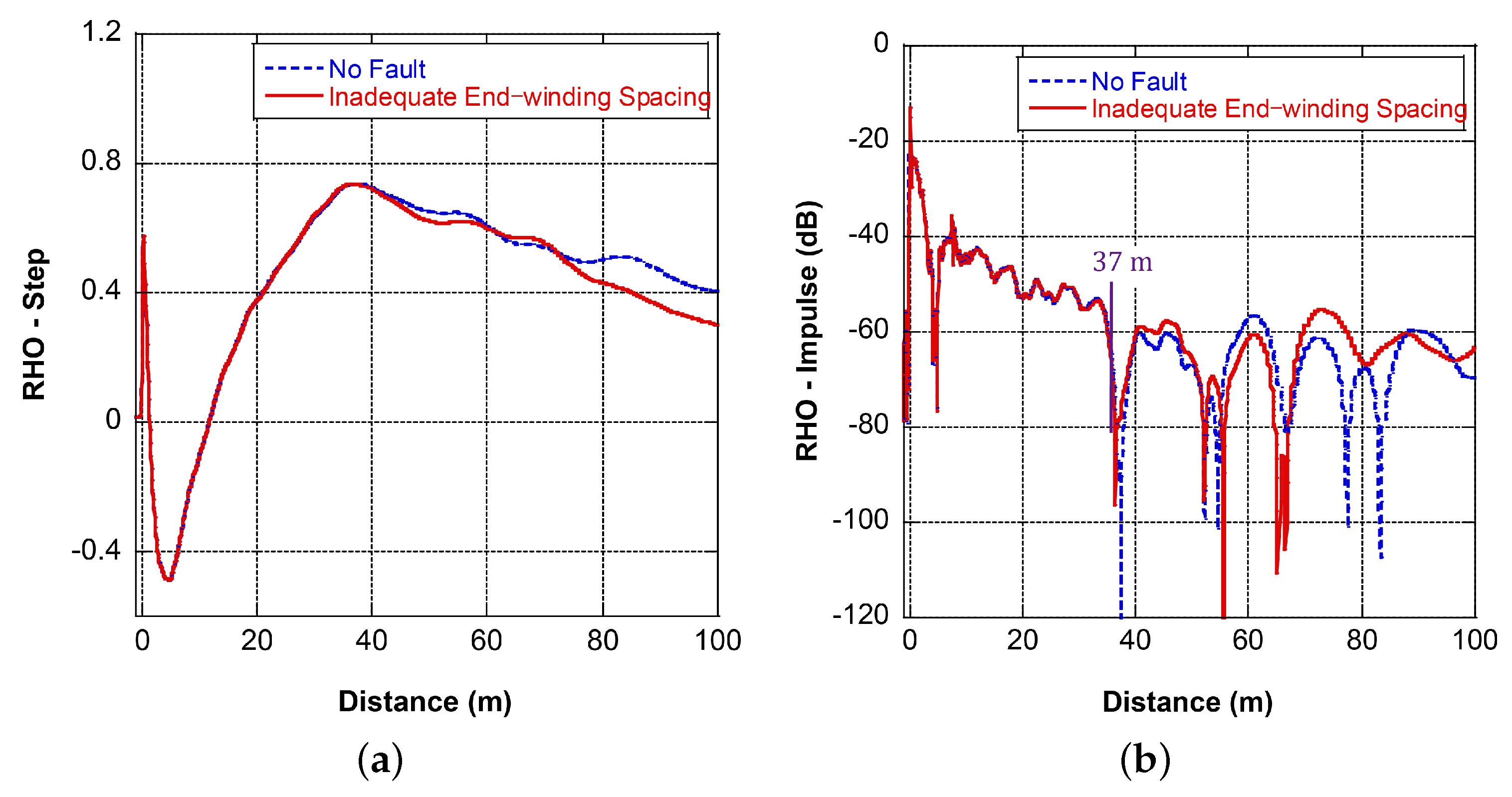

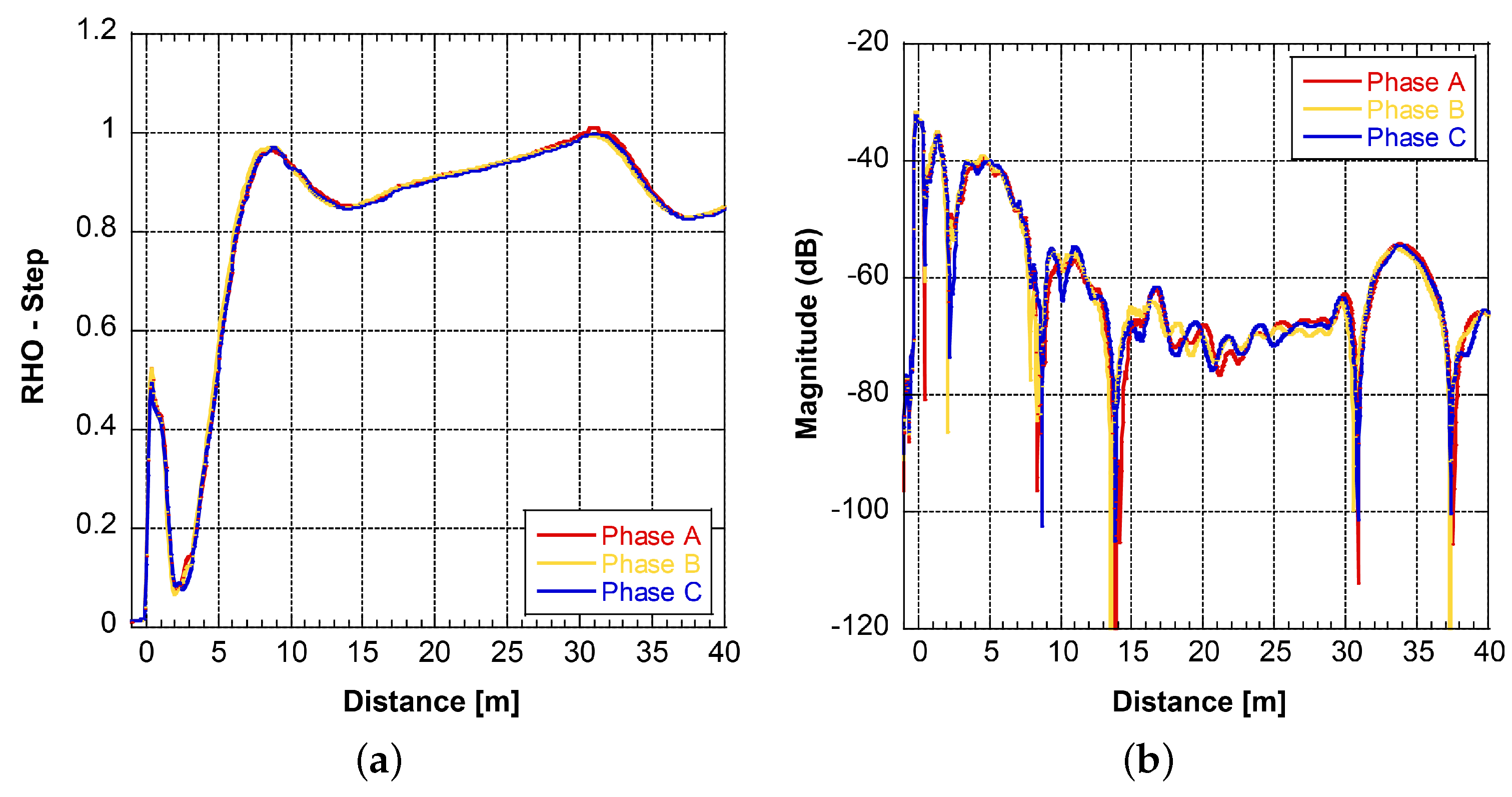
| No. | Power Rating (kW) | IR () | (%) | 1 (%) | 2 PD (pC) |
|---|---|---|---|---|---|
| 1 | 400 | 0.42 | 8.00 | 6.43 | 3760 |
| 2 | 400 | 4.50 | 6.49 | 6.80 | 1780 |
| 3 | 400 | 1.20 | 6.19 | 7.25 | 1000 |
| 4 | 315 | 0.012 | 13.08 | 1.64 | 630 |
| 5 | 315 | 0.049 | 13.95 | 1.13 | 460 |
| 6 | 315 | 0.041 | 18.78 | 1.52 | 820 |
| 7 | 3200 | 32 | 0.90 | 1.69 | 680 |
| 8 | 3200 | 45 | 0.85 | 1.29 | 5140 |
| 9 | 3200 | 7.1 | 2.23 | 1.54 | 15,900 |
| 10 | 4500 | 11 | 1.41 | 0.31 | 3820 |
| 11 | 4500 | 9.4 | 1.35 | 0.34 | 5350 |
| 12 | 4500 | 9.9 | 1.42 | 0.39 | 4120 |
| 13 | 300 | 34 | 0.76 | 12.92 | 15,800 |
| 14 | 300 | 49 | 0.67 | 1.72 | 9650 |
| Problems | FDR Characteristic | Fault Location (Detected/Actual) | FDR Sensitivity |
|---|---|---|---|
| End-winding discharge | A prominent drop in the magnitude at the fault location | 2.6 m/2.4 m | High |
| Turn-to-turn short | A prominent drop in the magnitude at the fault location; reduced apparent length | 2.6 m/2.4 m | High |
| Loose slot wedge | Slight increase in the step response magnitude at the fault location; reduced apparent length | 4.2 m/4.5 m | High/Medium |
| Local overheating | Periodic oscillation of the impulse response trace | 3.3 m/3.5 m | Medium |
| Tracking between coils | Obvious trace pattern change | 37 m/28.8 m | High |
Disclaimer/Publisher’s Note: The statements, opinions and data contained in all publications are solely those of the individual author(s) and contributor(s) and not of MDPI and/or the editor(s). MDPI and/or the editor(s) disclaim responsibility for any injury to people or property resulting from any ideas, methods, instructions or products referred to in the content. |
© 2023 by the authors. Licensee MDPI, Basel, Switzerland. This article is an open access article distributed under the terms and conditions of the Creative Commons Attribution (CC BY) license (https://creativecommons.org/licenses/by/4.0/).
Share and Cite
Cheng, J.; Zhang, Y.; Yun, H.; Wang, L.; Taylor, N. A Study of Frequency Domain Reflectometry Technique for High-Voltage Rotating Machine Winding Condition Assessment. Machines 2023, 11, 883. https://doi.org/10.3390/machines11090883
Cheng J, Zhang Y, Yun H, Wang L, Taylor N. A Study of Frequency Domain Reflectometry Technique for High-Voltage Rotating Machine Winding Condition Assessment. Machines. 2023; 11(9):883. https://doi.org/10.3390/machines11090883
Chicago/Turabian StyleCheng, Jialu, Yizhou Zhang, Hao Yun, Liang Wang, and Nathaniel Taylor. 2023. "A Study of Frequency Domain Reflectometry Technique for High-Voltage Rotating Machine Winding Condition Assessment" Machines 11, no. 9: 883. https://doi.org/10.3390/machines11090883





